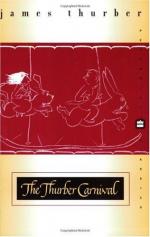|
This section contains 2,845 words (approx. 10 pages at 300 words per page) |

|
SOURCE: “Men and Animals: James Thurber and the Conversion of a Literary Genre,” in Studies in Short Fiction, Vol. 3, No. 3, Spring, 1966, pp. 307–13.
In the following essay, Triesch examines the ways in which Thurber changed the traditional form of the fable.
Speaking of the Human Habit of Ascribing Human Weaknesses to animals, James Thurber says that “the trouble with Man is Man. It is an immemorial convention of the writers of fables to invest the lower animals with the darker traits of human beings, so that by age-old habit, Man has come to blame his faults and flaws on the other creatures in his least possible of all worlds.”1 The implication, of course, is that man, not “the lower animals,” is to blame for the faults; and the fabulist merely uses the animals to objectify human weaknesses. In contemporary literature Thurber himself is the only established writer of fables...
|
This section contains 2,845 words (approx. 10 pages at 300 words per page) |

|


